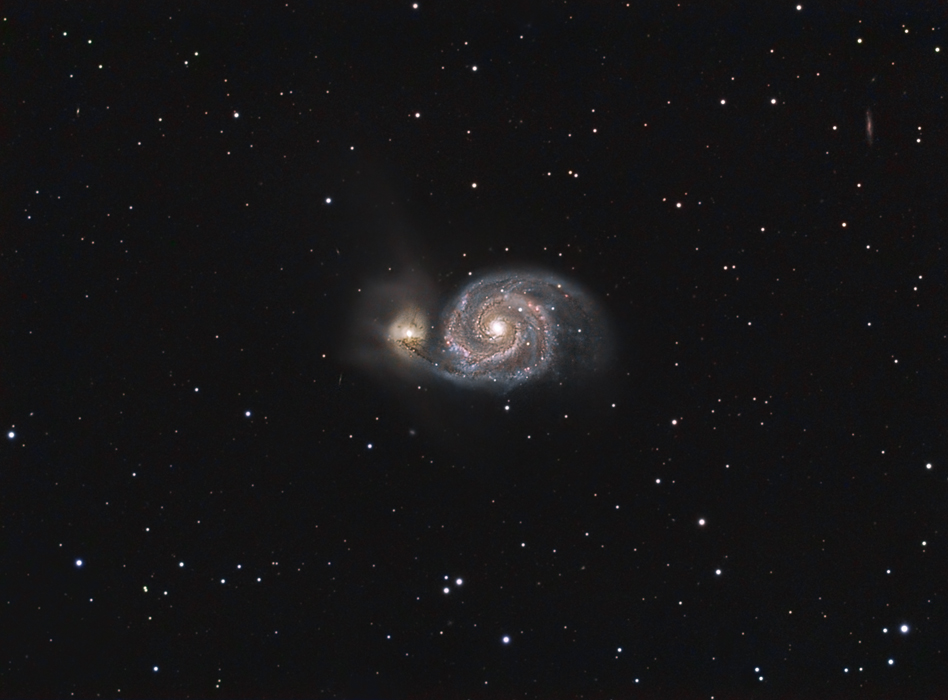M51 (Whirlpool Galaxy) and NGC 5195
Characteristics:
Magnitude: 8.4
Size: about 11' x 7'
Distance: 37 million light years
RA: 13h 30m 5.9s
Dec: 47 degrees 10' 04"
Description:
The famous face-on spiral galaxy M51
(NGC 5194) is located in the constellation Canes Venatici (Hunting
Dogs). It
was originally discovered by Charles Messier in 1773, although its true
spiral
structure was first realized by Lord Rosse
in 1845. The galaxy has a characteristic shape, in the form of an
inverted question mark, due to its association with another galaxy
located well behind M51 in the above photograph, known as NGC
5195. Note that this
smaller galaxy is seen edge on and is partly obscured by a long, thin,
prominent dust lane extending from M51. Interaction between M51
and NGC5195 is thought to trigger new star formation in M51 itself, as
represented by clusters of young, blue stars within the spiral
arms. M51 is a good target
for visual observation through small aperture telescopes in dark skies,
although it can be a challenging to discern its spiral structure in
more light polluted skies. Closer examination
of
this image reveals several other small galaxies, including IC4263,
IC4278, IC4277, and IC4282.
This represents the second light image from my new Takahashi FS-102,
which yields a FOV of 37' x 50' and an image scale of 2.15 arcsec/pixel
at f6 with the SXV-H9 camera. More
information
about M51
may be found here.
Photographic Details:
Date: March 16, 2005.
Scope: Takahashi
FS-102 at f6 with TOA-130 focal reducer, on the G11 Losmandy
Mount.
Autoguider: SBIG STV with
e-finder.
Camera: SXV-H9
Filter: Astronomik
Type II R, G, B, plus clear filter set.
Exposures: L:R:G:B. 18 x
10' subexposures for total 3 hours of luminance, unbinned; 20' each for
R, G, and B, binned 2 x 2. Total exposure duration 4 hours.
Conditions: Temperature 26 degrees F; average
transparency; average seeing; a few passing clouds.
Post-processing: No darks,
although bias-subtracted flats were used for this image.
Alignment
done in Maxim.
Sigma
combined using RC Sigma Reject Plug-in for MaximDL. DDP was
performed in ImagesPlus
(IP). Subsequent
levels and curves adjustments in Photoshop CS (16 bit format). I
used the Dynamic Background Extraction tool (DBE) of PixInsight to
correct for color gradients in the RGB image, prior to combining with
luminance. Final sharpening done with high pass filtering at a
radius of 1.5.
Please
note: Graphics on this website
may not be reproduced without author permission.
Back to Galaxies
Home
